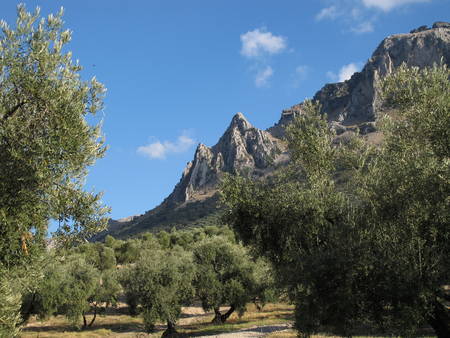
“Sierras Subbéticas: the Kingdom of Ammonites”
Sierras Subbéticas UNESCO Global Geopark is a mountainous area located in the central part of the “Betic Mountain Range” (South of Cordova province) coinciding with the geographical centre of Andalusia. Olive groves dominate the low and medium lands and represent the main economic activity. Mediterranean ecosystems characterize the UNESCO Global Geopark, where endemic species of flora remain isolated in the cusps after thousands of years.
The Sierras Subbéticas UNESCO Global Geopark are noted for their impressive karstic landscape. Massive limestone and dolostone mainly outcrop in higher terrains, where karst show a great variety of elements (poljes, great dolines, karrens, a recently occurred ponor and a dense network of cavities with about 900 caves and abysses inventoried). A very continuous and well exposed series of sedimentary rocks offer fundamental information about the last 230 million years of Subbetica’s geological history. Invertebrate marine fossils are very abundant, but the most important for their richness and scientific interest are ammonites. The UNESCO Global Geopark represents an extraordinary example of the evolution of the distal part of the South Iberian Margin (External Zones of the Betic Mountain Range) during Mesozoic. Extensive outcrops of condensed-pelagic facies (ammonitico rosso) yield abundant invertebrate fauna. Ammonites show very high diversity and abundance. The rich ammonite-bearing series permit high resolution bio-magnetostratigraphic studies that evidence the completeness of the stratigraphic record, especially that involving Jurassic-Cretaceous boundary. More than 80 new ammonite taxa have been defined from samples extracted in Sierras Subbéticas.
Associated to the karstic system important aquifers provide with fresh water the inhabitants of the district and the surroundings, and attracted first humans to settle in the area during Palaeolithic times.
The flora and fauna is particularly adapted to rocky environments and more than 1,200 plant species are catalogued, including at least 30 endemic species and several threatened species. Fungi are of exceptional interest, in particular regarding the diversity of the truffles.
The total population of Sierras Subbéticas UNESCO Global Geopark is 74,067 inhabitants (2002). Typical small white villages are located at the boundaries of the Geopark.
The Geopark is making continuous efforts to preserve and promote its valuable natural heritage. Annual courses are offered aimed at increasing general environmental awareness, knowledge of geological heritage and its close relation to natural and human history. There are important facilities to promote Geotourism: two Visitors’ Centers, a Mycological Garden (the first of its kind in Europe) and several geological routes. The involvement of local communities through collaboration with entrepreneurs, teachers, artists, politicians, etc. is essential to achieve the goals of a Geopark.
The Management Plan of the UNESCO Global Geopark guarantees sustainable development as well as environmental education in the whole territory. The management body controls the activities carried out by enterprises and landowners through an authorisation control system. A PDS (Sustainable Development Master Plan) was launched in 2004, which is updated periodically. A second PDS is projected to be written, with the participation of a working group that involves all local actors. Approximately thirty enterprises are involved with sustainable development and collaborate closely with the park, through the establishment of the “European Charter for Sustainable Tourism” and the ecolabel “Andalusian Natural Park”. With regards to environmental education, several programmes are offered in the UNESCO Global Geopark: “Nature and you”, for primary and secondary school and “The environmental rangers visit our school” for primary school. Training courses have been carried out for teachers. Popular science material and UNESCO Global Geopark infrastructure have been designed to be used as an excellent tool for education, in combination with activities in Nature.

.jpg)